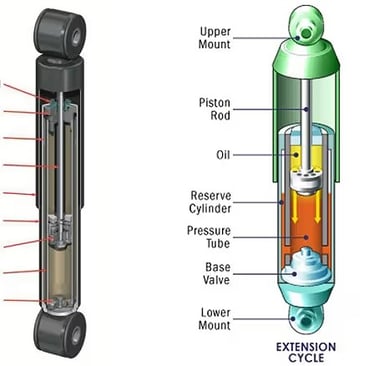The Mechanism of Shock Absorbers in Suspension Systems
2/2/20252 min read


Introduction to Suspension Systems
The role of suspension systems in vehicles is crucial for ensuring both comfort and safety while driving. At the heart of these systems are shock absorbers, which work diligently to manage the vehicle's interaction with the road. Understanding the mechanism of shock absorbers in suspension systems can provide valuable insights into how vehicles maintain stability and comfort over diverse terrains.
The Role of Shock Absorbers
Shock absorbers serve as a vital component in a vehicle’s suspension system. Their primary function is to control the impact and rebound movement of the vehicle's springs and suspension. During driving, the vehicle encounters various road conditions, leading to fluctuations in the body’s elevation and stability. Shock absorbers dampen these movements, ensuring that the vehicle does not excessively bounce or sway, which could otherwise compromise the safety of the occupants and the control of the vehicle.
How Shock Absorbers Work
The mechanism of shock absorbers can be summarized in a few key steps. First, shock absorbers convert kinetic energy caused by road irregularities into thermal energy through fluid displacement. When the vehicle encounters a bump, the shock absorber compresses, forcing hydraulic fluid through small orifices within the device. This movement creates resistance, which slows down and absorbs the energy from the compression of the spring.
On the rebound phase, the shock absorber extends, allowing the oil to move back into the reservoir and gradually returning the suspension components to their original position. This cycle of compression and rebound is repeated continuously as the vehicle moves, ensuring a smooth ride. By providing resistance to the oscillation of the springs, shock absorbers play a critical role in maintaining tire contact with the road, which enhances handling and stability.
Types of Shock Absorbers
There are several types of shock absorbers available, including twin-tube and mono-tube designs. Twin-tube shock absorbers consist of two tubes that house the fluid and the gas. They are commonly used in standard applications due to their cost-effectiveness. On the other hand, mono-tube shock absorbers feature a single tube design that offers better performance and is often utilized in performance and off-road vehicles due to their ability to dissipate heat more efficiently.
Understanding the mechanism of shock absorbers in the suspension system is essential for vehicle maintenance and performance enhancement. Regular checks and replacements can lead to improved ride quality, enhanced handling characteristics, and overall vehicle safety. With a well-functioning shock absorber mechanism, drivers can experience a more comfortable and stable ride, essential for everyday driving and longer journeys.
Support
Ask questions and share truck repair tips.
Connect
© 2025. All rights reserved.
